I know there is a “now”, a present, and I hope there will be a future. I know there is a present because I am living it as I type, but the past is just memories… Isn’t it?
Many people believe in an almighty creator, a supernatural entity that created life from nothing. If they are correct and the almighty creator exists, how can I be sure that I was not created today and that this morning was the first morning of my existence? Why would he make me start small, just a few cells? Why waste time in having me conceived in such a complicated way before making me grow big? The past is just memories, my childhood is just memories, how can I be certain I was not pre-programmed with those memories when I was “created”? After all, the past no longer exists, I just remember it.
When someone builds you a computer they can quite easily pre-programme information into the memory as it is built before you receive it. We could be just biological computers built by “the creator”, such a clever being must capable of anything, right?
(O.K. there is an argument that we are biological computers anyway, but that’s a different story.)
Maybe the makers of the film “The Matrix” were right and that we only exist in an artificial, programmed reality created by some all-seeing, all-knowing, higher, almighty being.
Or perhaps Douglas Adams was correct in his book “The Hitchhiker’s Guide to the Galaxy” and we are all part of an experiment being undertaken by mice (I quite like that idea). Although the people in his book did have a past, just not the one they had envisaged.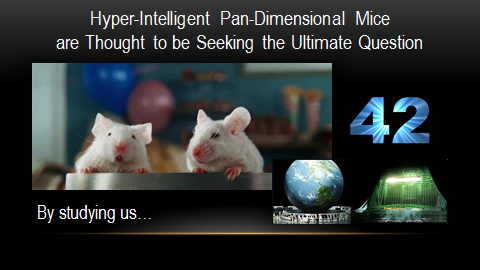
But overall, considering all the information before me, I think I did have a past because I simply cannot believe that any intelligent almighty creator would ever have been so stupid as to create such idiotic, arrogant, selfish, self-centred beings as the human race. They alone have evolved to make the world and life what it is today, and they will probably also be the architects of their own demise… and no sane creator could ever have thought up all the stupid, weird, tragic, hurtful, but sometimes amazing and wonderful, things that I store in my memory as my past so far.
So the past is not a pre-programmed memory, and tomorrow I will wake up (hopefully) when today will be the past. I will look back and remember the things that happened, the mistakes I made, the good times and the bad. I will be happy and nostalgic; I will be grateful that I have so far survived, while feeling sad for those that haven’t; I will enjoy the present, looking forward to the future when “now” is a distant memory, and I will ponder whether it all really happened.
Then I find that someone else has these thoughts too:
Is this the Real Life (Or is this just fantasy?)?


 has many currents often unseen, it can have falls and eddies; it can divide making us chose a direction without knowing the consequences; it can temporarily turn us back or spiral us down in a whirlpool from where we may never return.
has many currents often unseen, it can have falls and eddies; it can divide making us chose a direction without knowing the consequences; it can temporarily turn us back or spiral us down in a whirlpool from where we may never return.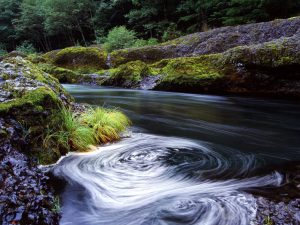


 Dropping down from the sometimes bleak yet beautiful North Yorkshire Moors we see the distant shimmer of the North Sea reflecting blue from the warm late summer sky. The sea glints and sparkles passively in the gentle off-shore breeze and the small town of Whitby nestles seemingly peacefully in the valley. The town straddles the estuary of the River Esk as it discharges its peaty brown heath and moorland waters into the green/blue vastness of the open sea. We can see the ruins of the cliff top Abbey silhouetted against the watery backdrop and the ancient lighthouse that marks the harbour pier. As we descend through the village of Sleights the distant view of hills, valley, sea and town is lost, but soon we will arrive.
Dropping down from the sometimes bleak yet beautiful North Yorkshire Moors we see the distant shimmer of the North Sea reflecting blue from the warm late summer sky. The sea glints and sparkles passively in the gentle off-shore breeze and the small town of Whitby nestles seemingly peacefully in the valley. The town straddles the estuary of the River Esk as it discharges its peaty brown heath and moorland waters into the green/blue vastness of the open sea. We can see the ruins of the cliff top Abbey silhouetted against the watery backdrop and the ancient lighthouse that marks the harbour pier. As we descend through the village of Sleights the distant view of hills, valley, sea and town is lost, but soon we will arrive. It is still holiday season, the town is full of happy people escaping the reality of work and daily routine. Around the harbour there is a smell of street food; fish and chips, cockles, whelks, hot-dogs, burgers, doughnuts. On the west side of the river are the amusement arcades, the fish docks and cafes. Behind and above on the steep sided valley on this north side is the
It is still holiday season, the town is full of happy people escaping the reality of work and daily routine. Around the harbour there is a smell of street food; fish and chips, cockles, whelks, hot-dogs, burgers, doughnuts. On the west side of the river are the amusement arcades, the fish docks and cafes. Behind and above on the steep sided valley on this north side is the  f town with the main streets and cliff top guest houses. The Royal Hotel, where Bram Stoker reputedly stayed and was inspired by the view across the harbour towards the Abbey to write the novel “Dracula”, sits atop the cliff behind the famous whale bone arch. The Victorian grandeur is long gone but signs of its heyday are everywhere. On the east side of the river is the ancient part of Whitby dating back to the 1500s and still with many old characterful terraced cottages and cobbled streets.
f town with the main streets and cliff top guest houses. The Royal Hotel, where Bram Stoker reputedly stayed and was inspired by the view across the harbour towards the Abbey to write the novel “Dracula”, sits atop the cliff behind the famous whale bone arch. The Victorian grandeur is long gone but signs of its heyday are everywhere. On the east side of the river is the ancient part of Whitby dating back to the 1500s and still with many old characterful terraced cottages and cobbled streets.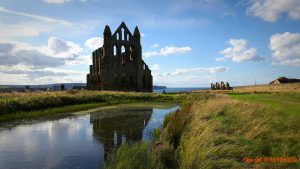 Some properties in the town would have originally been occupied by ancient whalers and fishermen living hard and dangerous lives, yet in a different era others would have been occupied by wealthy Victorians and Edwardians who would promenade along the harbour walls and cliff-tops in their extravagant finery. Now these same properties are often holiday homes, sadly unoccupied for half the year giving the town a slightly ghostly feel on quiet dull days mid-winter. It is difficult to imagine the ancient fishermen mending their nets around the harbour that would be packed full with enumerable working sailing ships, or later the ladies discretely enjoying the waters of the sea
Some properties in the town would have originally been occupied by ancient whalers and fishermen living hard and dangerous lives, yet in a different era others would have been occupied by wealthy Victorians and Edwardians who would promenade along the harbour walls and cliff-tops in their extravagant finery. Now these same properties are often holiday homes, sadly unoccupied for half the year giving the town a slightly ghostly feel on quiet dull days mid-winter. It is difficult to imagine the ancient fishermen mending their nets around the harbour that would be packed full with enumerable working sailing ships, or later the ladies discretely enjoying the waters of the sea  via their “
via their “


 waters below the falls, gulls and cormorants are feeding where they can, unconcerned about the dangers and oblivious to the beauty.
waters below the falls, gulls and cormorants are feeding where they can, unconcerned about the dangers and oblivious to the beauty. The normally garish town is quiet; the summer chaos and noise; the smell of fast food; the holiday revellers, all thankfully absent. Niagara is an icy ghost town except for those hardy travellers seeking out the beauty of winter, if we face the river we can ignore the rampant commercialism even from within the warm confines of the hotel….. but the clear frosty morning air beckons, it’s time for a walk to feel the biting cold on my face, to feel the vibrations of the falls beneath my feet, to hear the deafening roar and remember it until the next visit. Maybe it will still be here, unless it is destroyed further by our human presence. The apparently uncontrollable power of the water is already reduced to a virtual trickle through our demands for electricity, the water flows being diverted to hydroelectric power stations. Knowing we can turn it “off” an “on” at the flick of a switch somehow detracts from its natural beauty and coupled with the corporate commercialism now evident at every view point I have mixed feelings. Perhaps the romance is not in the place itself but in the person we visit it with?
The normally garish town is quiet; the summer chaos and noise; the smell of fast food; the holiday revellers, all thankfully absent. Niagara is an icy ghost town except for those hardy travellers seeking out the beauty of winter, if we face the river we can ignore the rampant commercialism even from within the warm confines of the hotel….. but the clear frosty morning air beckons, it’s time for a walk to feel the biting cold on my face, to feel the vibrations of the falls beneath my feet, to hear the deafening roar and remember it until the next visit. Maybe it will still be here, unless it is destroyed further by our human presence. The apparently uncontrollable power of the water is already reduced to a virtual trickle through our demands for electricity, the water flows being diverted to hydroelectric power stations. Knowing we can turn it “off” an “on” at the flick of a switch somehow detracts from its natural beauty and coupled with the corporate commercialism now evident at every view point I have mixed feelings. Perhaps the romance is not in the place itself but in the person we visit it with?


 urful parks, or on the wild moorlands and hill tops where the stress and noise of modern life is left far behind, replaced by the sound of the wind, the rustling of trees and the call of the birds.
urful parks, or on the wild moorlands and hill tops where the stress and noise of modern life is left far behind, replaced by the sound of the wind, the rustling of trees and the call of the birds. Wherever I am in the UK I am little more than one hour from the coast; the gentle lapping of sea on the shore or the thunder of waves against soaring cliffs; the screech of gulls and the smells of salt air and sea shore; the atmosphere is invigorating and brings renewed life and vigour to a tired soul.
Wherever I am in the UK I am little more than one hour from the coast; the gentle lapping of sea on the shore or the thunder of waves against soaring cliffs; the screech of gulls and the smells of salt air and sea shore; the atmosphere is invigorating and brings renewed life and vigour to a tired soul.


 A small town in the north east of England in the county of South Yorkshire.
A small town in the north east of England in the county of South Yorkshire.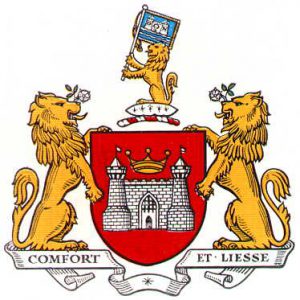 Doncaster began when the Romans built a fort in the area about 71 AD. The Romans called the fort Danum. However in the 4th century Roman civilisation declined and the last Roman soldiers left Britain in 407 AD.
Doncaster began when the Romans built a fort in the area about 71 AD. The Romans called the fort Danum. However in the 4th century Roman civilisation declined and the last Roman soldiers left Britain in 407 AD. 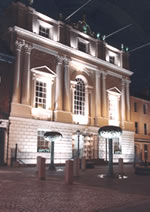
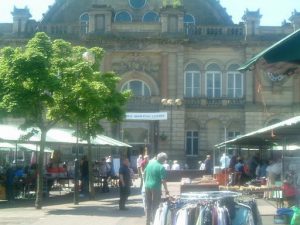 In the 14th century friars arrived in Doncaster. The friars were like monks but instead of withdrawing from the world they went out to preach. In 1307 Franciscan friars arrived in Doncaster. They were called grey friars because of the colour of their costumes. Carmelites or white friars arrived in the middle of the 14th century.
In the 14th century friars arrived in Doncaster. The friars were like monks but instead of withdrawing from the world they went out to preach. In 1307 Franciscan friars arrived in Doncaster. They were called grey friars because of the colour of their costumes. Carmelites or white friars arrived in the middle of the 14th century. Racecourse and the founding of the Great Northern Railway Locomotive and Carriage Buildings Works, the factory that built the Flying Scotsman and the Mallard, brought further recognition.
Racecourse and the founding of the Great Northern Railway Locomotive and Carriage Buildings Works, the factory that built the Flying Scotsman and the Mallard, brought further recognition. The spectacular white circular keep of Conisbrough Castle dates back to approximately 1180. Made of magnesian limestone, it is the oldest circular keep in England.
The spectacular white circular keep of Conisbrough Castle dates back to approximately 1180. Made of magnesian limestone, it is the oldest circular keep in England.

